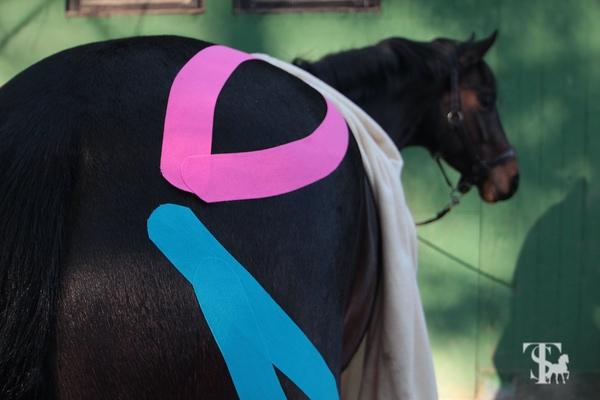
Horse Problem? Maybe Tape Can Fix It!
From ‘Kinesiology Taping for Horses.’
Kinesiology taping on human athletes is widely used by physical therapists, chiropractors, and personal trainers; we see it on Olympians, runners, basketball players—on amateurs and professionals. As we learn in this excerpt from the book Kinesiology Taping for Horses by Katja Bredlau-Morich, our equine athletes can benefit hugely from taping techniques, too.
Kinesiology tape is applied to the skin with varying amounts of stretch, depending on the kind of application. Considering basic physical laws, everything that is stretched has a tendency to recoil. Thus when the stretched tape is applied, it recoils and thereby lifts the skin or—in case of a horse—the hair coat and the skin. And that is the basic effect of kinesiology tape: it lifts the outer layer of the skin, and with horses, the hair coat and the skin. Lifting the outer layer of the skin increases the space in the tissue underneath, allowing blood and lymphatic fluid to flow more easily. Waste products will be washed out and new blood with nutrients and oxygen can flow in, improving circulation. This “lifting” effect continues on to the next tissue layer underneath, then into the next, and the next…. This increase in space makes it possible to affect deeper tissue layers and provide pressure and pain relief. For example, arthritic side effects like pain and stiffness can be treated. The arthritis itself, of course, is an irreversible process that we can’t undo, but the kinesiology taping can help to make life a little more comfortable for the patient.
Here are a few of the problems where a little tape can help:
Pressure Relief
Inflammatory processes, swellings, and even sore and tight muscles will cause an increase in tissue volume, which then leads to more pressure in the affected area. As described before, kinesiology tape lifts the skin and creates space in the tissue. As a result, this increased space will take away the pressure from inflammation, blood vessels, and even from muscles.
Pain Relief
As just mentioned, a tight muscle has an increased tissue volume that causes swelling. The swelling puts pressure on pain receptors, so the tight muscle hurts.
Because of pressure relief the tape provides, it also removes the pressure from pain receptors; therefore, kinesiology taping helps to relieve pain.
Circulation Improvement
When there is a swelling like a hematoma or lymphangitis, the fluids in the affected tissue build up (in horses this is known as stocking up). With the “lifting” effect of the kinesiology tape, more space is created in this stocked-up area and the fluids (blood/lymphatic fluids) can flow more easily: waste products are being washed out and new fluids brought into the area, fluid retention disappears, and circulation improves.
Support of Joint Mobility
The relief of pressure in a tight, sore, or swollen joint leads to better and improved mobility and greater range of motion. Because of the tape’s skin-like character, it adheres around the joint, giving it support without causing any motion restrictions.
Support of Muscle Activity
Depending on the direction of the muscle application, kinesiology tape can either support or relax a muscle, and regulate the muscle tone. The improved blood flow in the taped area brings more oxygen and nutrients to the muscle, which has a positive effect on muscle activity.
Improvement of Proprioception
Proprioception is described as body awareness and the sense of position of the body and body parts in relation to each other and the surrounding environment. If I close my eyes and move my arm, my brain and my body still know where my arm is and what it is doing—at my side, above my head, flexing the elbow, and so on.
Proprioception is based on a sensory system with peripheral receptors called proprioceptors. These are specialized sensory cells, which can be found in all different kinds of tissue in muscle cells, in tendons, in the connective tissue, and also in the fascia. Recent studies show that fascia contain many more proprioceptors than all the other tissues, proving again how important fascia are. These specific receptors give constant feedback to the brain about the condition and tension in the tissue, as well as changes therein.
Superficial fascia and their proprioceptors, as well as mechanoreceptors for movement, are located directly under the skin; therefore, they can easily be stimulated with kinesiology tape and body awareness can be improved. I witnessed this once very dramatically on an older mare that was over at the knee and had a constant wobble in both front legs. During a taping course, we were practicing lymphatic tapings. I demonstrated a lymphatic row with strips along one of the mare’s front legs. While we were still standing next to the horse, discussing the lymphatic taping, we observed the wobble on the taped leg become less noticeable, and how the knee was getting slightly straighter. Suddenly the mare was standing much more relaxed on this limb. The lymphatic tape had nothing to do with the malposition of that front leg, neither was there an actual lymphatic problem at that moment (the taping was just for demonstration purposes), but it had quite the effect on her body awareness right then, right there!
This excerpt from Kinesiology Taping for Horses by Katja Bredlau-Morich is reprinted with permission from Trafalgar Square Books (www.horseandriderbooks.com).








Leave a Comment